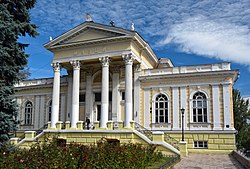Odesa Archaeological Museum
Одеський археологічний музей | |
 | |
 | |
| Established | 1825 |
|---|---|
| Location | 4 Lanzheronivska Street, |
| Coordinates | 46°29′6.13″N30°44′38.3″E/ 46.4850361°N 30.743972°E |
| Collection size | 160,000 |
| Director | Ihor Bruyako |
| Website | www |
TheOdesa Archaeological Museum(Ukrainian:Одеський археологічний музей) is one of the oldestarchaeological museumsinUkraine.It was founded in 1825; the current museum building was completed in 1883 according to a design by Polish architect Feliks Gąsiorowski.[1][2]
The museum's address is 4 Lanzheronivska Street, 65026,Odesa,Ukraine.
History
[edit]Founded in1825as the "Odessa City Museum of Antiquities" byIvan Blaramberg.Its development was facilitated by the Imperial Odessa Society of History and Antiquities, which had the right to conductexcavationsin the southRussian Empire.
- The first director of the museum wasIvan Blaramberg[3][4]
- In 1913–1919 the museum was headed byBoris Varneke
- In 1930–1932 the director of the museum wasMikhail Boltenko
- In 1936–1937Tikhon Vnukovwas the director of the museum
- In 1959–1961Moses Sinitsynheaded the archaeological museum.
Since 1997, the Odesa Archaeological Museum has functioned not only as a museum but also as an institute for scientific research into the archaeology of early human settlement in the NorthernBlack Searegion and the archaeology of theMiddle Ages.The museum conducts expositions, restorations and publishing activities.
Exhibition activity
[edit]The main fund of the museum is the largest collection of sources on the ancient history of the NorthernBlack Seacoast, it has more than 170 thousand archaeological sources of ancient history ofsouthern Ukrainefrom theStone Ageto theMiddle Ages,including 55 thousand coins, the only collection of monuments in Ukraine ofAncient Egypt,the largest collection of ancient rarities in the country.
The best examples of ancient sculpture are exhibited in the lobby of the building, specially built for the Public Library in 1883. The first two halls display materials covering the period from the advent of man to thesecond millennium BC.Of particular interest are finds from settlements and cemeteries of the Humelnytsia,Trypillia,andUsatovo cultures,burial mounds, andBronze Agetreasures, such as the Antonivsky Treasure.

The "Golden Pantry" of the museum exhibits real things made of precious metals, the oldest of which date back to the beginning of the second millennium BC. Decorations fromScythianandSarmatiancemeteries, medieval burials of nomads, and products of Slavic craftsmen attract attention.
Out of the 50,000 coins stored in the museum, the rarest of gold and silver minted inancient Greece,Rome,Byzantium,andKyivan Rusare on display. In particular, the "gold coin" ofPrince Volodymyr,one of the two in Ukraine and of 11 known, is on the display.
The collection of Egyptian antiquities is the third largest in theformer USSR.Wooden and stonesarcophagus,funeral utensils, stone slabs and fragments ofpapyruswithhieroglyphsare of interest here.
Research activities
[edit]The museum conducts extensive archaeological researches on many monuments of theEneolithicandBronze Ages(for example, the settlement of the late Trypillia culture Usatovo, Mayaki). Monuments of the EarlyIron Agein the lower reaches of theDanube(Orlivka-Kartal),ancient times– on the banks of theDniesterestuary (the city ofNikonion), Odesa Bay – Tiligula are also studied. The museum expedition is conducting research onSnake Island.
The scientific activity of the museum is reflected in numerous publications, scientists of the museum maintain active scientific ties with Ukrainian and foreign colleagues. Joint research activities are conducted with specialists fromBulgaria,Great Britain,Greece,Denmark,Egypt,Germany,Poland,Romania,Franceand others. The museum participates in exhibitions abroad.
In the 1920s and 1930s there was a postgraduate course at the museum, in which future famous Odesa researchers studied (Virkau M.M., Sinitsyn M.S. and others).
Gallery
[edit]-
Marble bull,Niconium
-
Terracotta and bronze figurines,Bosporan Kingdom
-
Funeral stele fromOlbia
-
Head ofHerafrom Olbia
-
Ancient Egyptiansarcophagus
References
[edit]- ^"The Odessa Archaeological Museum".Archived fromthe originalon 11 January 2022.Retrieved16 April2021.
- ^"Szyk czarnomorski"(in Polish).Retrieved16 April2021.
- ^Бларамберг Иван Павлович — археолог,сайт «Белгород-Днестровский и Затока
- ^Иван Павлович Бларамберг,12.12.2013, сайт «Пантикапей»
External links
[edit]- Museums in Odesa
- Archaeological museums in Ukraine
- History museums in Ukraine
- Science and technology in Odesa
- Institutes of the National Academy of Sciences of Ukraine
- NASU department of history, philosophy and law
- National Academy of Sciences of Ukraine
- Art museums and galleries established in 1825
- 1820s establishments in Ukraine
- 1825 establishments in the Russian Empire
- Museums established in 1883
- 1880s establishments in Ukraine
- 1883 establishments in the Russian Empire
- Neoclassical architecture in Ukraine
- Research institutes in Ukraine
- Odesa Archaeological Museum





